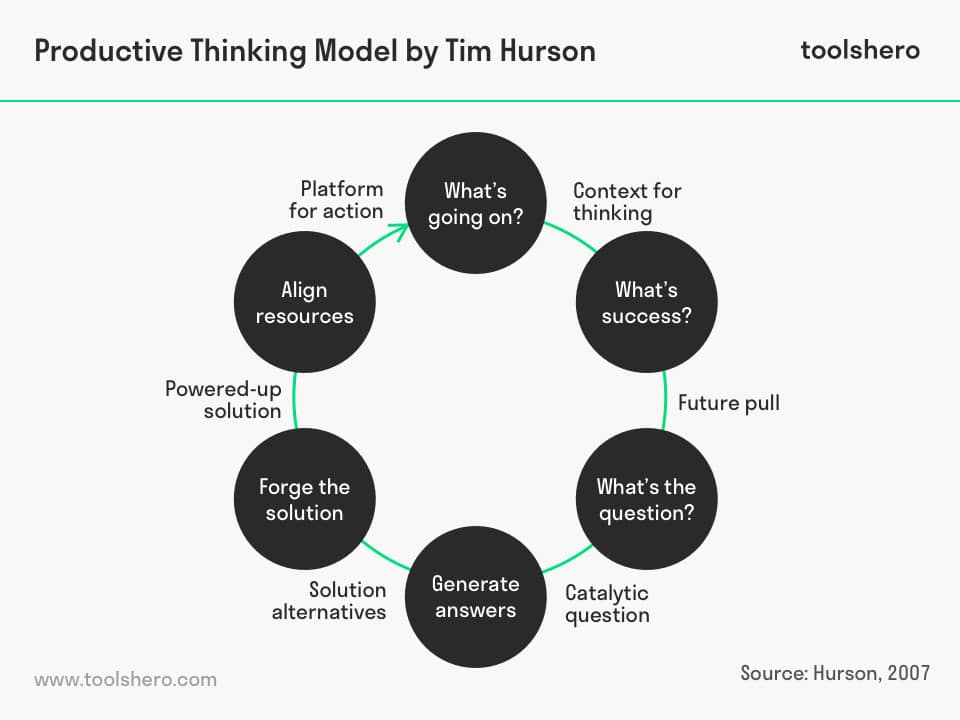Productive Thinking Model (PTM)

Productive Thinking Model: this article explains Productive Thinking Model, also know as or the Thinkx, developed by Tim Hurson in a practical way. After reading you will understand the basics of this powerful problem solving tool.
What is the Productive Thinking Model?
Anyone can learn to think creatively and productively and put this into practice. This is the base for the Productive Thinking Model (PTM) or Thinkx which was developed by Tim Hurson, a Canadian author.
In his book Think Better (2010), Tim Hurson presents a framework for creative and productive thinking. His approach describes six steps towards the development of good ideas. Productive Thinking Model seems to be a childishly simple approach, however it is very effective and powerful. It is a structured approach to solving problems in the most creative way possible.
Productive Thinking Model, a 6 step framework
Each step within the framework consists of different parts and techniques. The different steps contain questions that can be answered in a creative manner.
Furthermore, it is possible to brainstorm and confer with other stakeholders. It is this part of the process that encourages creative thinking. Productive Thinking Model is especially functional when a problem is determined in advance or when there is a desire for improvement or when a sales or innovation problem must be described. Productive Thinking Model enables more focused answers to each of the questions within the six-step framework. It creates a realistic, detailed idea or solution within a short period of time. By following the sequence of the six steps, creativity arises naturally.
Step 1 – What´s going on?
By answering the five questions (with multiple sub questions), the subject is tackled in the broadest possible way. The following questions are considered in the first step:
- What is the problem? / What is the question?
- What is the impact of this possible problem?
- What information do we already have? What information do we need in relation to the problem and/or question?
- Who is already involved in the problem or question?
- What is the vision of the situation and what does the Target Future look like?
Step 2 – What´s success?
In this second step it is about developing the Target Future into a concrete, desired situation. What could eventually lead to success? Using this step specific and observable success criteria can be defined which enable you to imagine how this objective can be met in the best possible way. You are allowed to use your senses and questions like ‘how does it feel, what will it look like and “what are your thoughts on this” can direct the brainstorm more concretely towards the desired output. By defining success criteria in advance, the ideas that stakeholders come up with can be assessed more effectively.
The success criteria are described using DRIVE, which is an acronym for Do – Restrictions – Investment – Values – Essential outcomes; what do you want the solution to do – what are the restrictions, what resources are available to achieve your objective, what values must this objective deliver – what outcome must it have?
The outcome of this step makes that the vision of what you want to achieve is not only clear but highly motivating.
Step 3 – What´s the question?
This step addresses the order in which essential questions must be answered to achieve the Target Future. These are the so-called catalytic questions that put the wheels in motion. It is about trying to ask the right questions in which it is important to identify each problem with respect to the central subject. From this the catalytic questions are distilled to achieve the Future Target.
Step 4 – Generate Answers
At this stage many ideas are generated. By getting as many answers to the catalytic questions as possible, stakeholders will come up with promising and intriguing ideas that can be developed. At this stage long lists of ideas and answers are created from which the best ones are chosen. This stage is not yet about definitive solutions, but it establishes a basis.
Step 5 – Forge the solution
In step 5 the ideas selected from step 4 are developed into a solution. This works best when the most promising ideas are compared with the success criteria that were identified in step 2. The ideas that meet the criteria best can then be further developed.
Step 6 – Align Resources
In this last step you determine which actions and resources are necessary to implement the definitive idea. You also identify the people who will be responsible for the implementation of the specific parts of the idea and what other resources are required. This part of the process will have to be fleshed out in detail and is therefore relatively time consuming.
Encouraging creativity
The advantage of the Productive Thinking Model is that it stimulates people to think critically and creatively and use their skills in each stage of the problem solving process. The Productive Thinking Model encourages creativity, which makes it easier to find good and useful solutions. The flow of ideas generated by the Productive Thinking Model, enables the filtering of multiple usable solutions. Moreover, creativity is combined with critical thinking. This contributes to a better understanding, a grip on the problems as well as swift solutions.
It’s Your Turn
What do you think?can you apply the Productive Thinking Modelin today’s business companies? And if so, how do you use it and what are your general results and learning lessons? Are the basics the same or are there new steps?
Share your experience and knowledge in the comments box below.
More information
- Gallagher, J. J. (1964). Productive thinking. Review of child development Research, 1, 359.
- Hurson, T. (2010). Think better: An innovator’s guide to productive thinking. McGraw Hill Professional.
How to cite this article:
Mulder, P. (2016). Productive Thinking Model (PTM). Retrieved [insert date] from toolshero: https://www.toolshero.com/problem-solving/productive-thinking-model/
Add a link to this page on your website:
<a href=”https://www.toolshero.com/problem-solving/productive-thinking-model/”>toolshero: Productive Thinking Model (PTM)</a>
,
Published on: 07/11/2016 | Last update: 04/03/2022








3 responses to “Productive Thinking Model (PTM)”
So, what’s a good way to be more creative in your problem-solving, and come up with the best ideas to move forward with? Hurson’s Productive Thinking Model could be just the thing to help you. This framework encourages you to use creativity and critical thinking at each stage of the problem-solving process. This means that you get a better understanding of the problems you face, and you come up with better ideas and solutions.
Dear Malinina, thank you for great comment. I totally agree on your statement. Kind regards Vincent
After identifying the right questions to address, the focus should be on the answers. Stakeholders try to answer these question in a sense of solving the problem. The answers are discussed in order to reach the best solution that can achieve the organizational target. The list of answers should be collected without excluding any one. Each answer can be a potential solution for the problem. It is like brainstorming for different solutions and collecting them for further analysis.